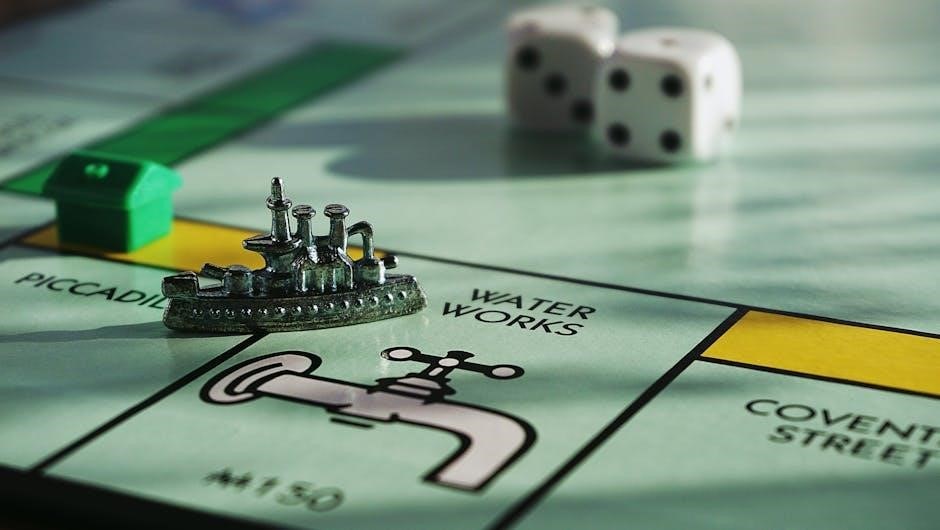Cribbage is a classic two-player card game played with a standard 52-card deck. It combines strategy and luck, focusing on quick counting and scoring combinations. Cribbage rules for 2 players are straightforward, making it an excellent choice for both beginners and experienced players. The game’s unique scoring system and use of a cribbage board add to its charm and complexity. Whether you’re learning or refining your skills, cribbage offers endless entertainment and mental stimulation.
1.1 What is Cribbage?
Cribbage is a popular two-player card game played with a standard 52-card deck. It combines strategy and luck, focusing on scoring points through card combinations like pairs, runs, and fifteens. A unique feature is the “crib,” a set of cards reserved for the dealer, adding an extra layer of scoring potential. The game is known for its use of a cribbage board and pegs, which streamline scoring and make the game fast-paced and engaging. Cribbage is a timeless classic, enjoyed for its balance of skill and chance.
1.2 Popularity of Cribbage as a Two-Player Game
Cribbage is a beloved two-player game due to its strategic depth and simplicity. Its popularity stems from its balance of luck and skill, making it accessible to newcomers while offering depth for experienced players. The use of a cribbage board and pegs adds a unique, tactile element that enhances gameplay. As a two-player game, it fosters direct competition and camaraderie, making it a favorite among card enthusiasts. Its enduring appeal lies in its mental stimulation and the joy of outscoring opponents through clever combinations and tactics.

Equipment Needed for Two-Player Cribbage
A standard 52-card deck, a cribbage board with holes for pegging, and two pegs per player are essential. A toothpick can substitute if a peg is missing.
2.1 Standard 52-Card Deck
A standard 52-card deck is required for two-player cribbage, with no jokers included. The deck consists of 13 ranks in each of the four suits: hearts, diamonds, clubs, and spades. Cards rank from King (highest) to Ace (lowest), with Kings, Queens, Jacks, and 10s each valued at 10 points. Numeric cards 2-9 retain their face value, while Aces count as 1. This deck setup ensures consistent gameplay and scoring, adhering to traditional cribbage rules. Jokers are explicitly removed to maintain the game’s integrity and simplicity.
2.2 Cribbage Board
A cribbage board is essential for scoring and tracking progress in the game. It features a series of holes where players place pegs to mark their points. The board’s layout includes two tracks, one for each player, with starting positions for the pegs. This tool eliminates the need for pen and paper, making scoring faster and reducing errors. The cribbage board is a iconic part of the game, available in various designs but always serving the same purpose. Pegs are included with the board or can be improvised if needed.
2.3 Pegs for Scoring
Pegs are small markers used to track players’ scores on the cribbage board. Each player uses two pegs, typically included with the board. These pegs are placed in the holes along the board’s tracks to mark points earned during the game. If pegs are lost, items like toothpicks can serve as substitutes. Pegging is a key part of cribbage, allowing players to visually track their progress toward the target score of 121 points. This method ensures quick and accurate scoring, enhancing the game’s efficiency and enjoyment.
Setup and Initial Preparations
Remove jokers from the deck and determine the dealer. Each player receives six cards, discarding two to form the crib. Pegs are placed at starting positions.
3.1 Removing Jokers from the Deck
Removing jokers from the deck is the first step in setting up a two-player cribbage game. The game is played with a standard 52-card pack, and jokers are not used. This ensures the deck consists only of the necessary cards for scoring combinations and gameplay. By eliminating jokers, the game maintains its traditional structure and prevents any confusion or complications during play. This step is crucial for a fair and standardized game setup, allowing players to focus on strategy and card counting.
3.2 Determining the Dealer
Determining the dealer in a two-player cribbage game is done by cutting the deck. Players take turns cutting, and the person with the lowest card becomes the dealer. If both players cut cards of the same rank, they cut again until a winner is decided. After the first hand, the deal alternates between players, moving clockwise. This method ensures fairness and provides both players with equal opportunities to deal throughout the game, maintaining balance and variety in gameplay.
3.3 Dealing the Cards
In a two-player cribbage game, the dealer shuffles the deck and offers it to the opponent to cut. The dealer then deals six cards to each player, starting with the opponent. Both players discard two cards face down to form the crib, which belongs to the dealer. The remaining cards are placed face down in a pile, with the top card turned over to serve as the starter card for the game. This process ensures a fair distribution of cards and sets the stage for gameplay.

The Crib in Two-Player Cribbage
The crib is a key component in two-player cribbage, consisting of two cards discarded by each player. It is unique to the dealer, offering a strategic advantage. The crib is scored separately at the end of the hand, adding an extra layer of complexity and excitement to the game. Understanding the crib’s role is essential for mastering cribbage, as it can significantly influence the final score and outcome.
4.1 What is the Crib?
The crib is a unique set of four cards in two-player cribbage, consisting of two cards discarded by each player. It is exclusively used by the dealer for scoring at the end of the hand. The crib is separate from the cards played during the game and is scored based on standard cribbage rules, including combinations like pairs, runs, flushes, and nobs. The crib adds a strategic element, as the dealer aims to maximize points from these cards, making it a crucial part of the game’s scoring system.
4.2 How the Crib is Formed
In two-player cribbage, the crib is formed by each player discarding two cards from their six-card hand. These four discarded cards are placed face down in front of the dealer. The dealer then takes these cards, along with the starter card (the top card of the remaining deck after dealing), to form the crib. The crib is scored separately at the end of the hand, giving the dealer an opportunity to earn additional points. This unique process adds a strategic layer to the game, as players must balance their hand with potential crib contributions.
4.3 Importance of the Crib in Scoring
The crib holds significant importance in scoring, as it provides the dealer with an exclusive opportunity to earn points. After the main hand is played, the dealer reveals and scores the crib, which includes the four discarded cards and the starter card. Points are awarded for combinations like pairs, runs, flushes, and nobs, similar to the main hand. The crib can substantially influence the game’s outcome, often making the difference in reaching the target score of 121 points. It adds a strategic layer, as players must balance their hand play with potential crib contributions.

Scoring in Cribbage
Scoring in cribbage involves points for pairs, runs, flushes, and nobs. The crib is scored separately, and pegging tracks points on the board efficiently.
5.1 General Scoring Rules
In cribbage, scoring is based on card combinations and sequences. Points are awarded for pairs, runs, flushes, and nobs. The crib, a special set of cards, is scored separately. Pegging on the board tracks points during play, ensuring accurate scoring. The goal is to be the first to reach 121 points. Double skunk occurs if a player wins by 61 points or more. Understanding these rules is essential for mastering the game and enjoying its strategic depth.
5.2 Counting Points During Play
In cribbage, points are counted during play for combinations such as pairs, runs, flushes, and nobs. Players use pegs on the cribbage board to track their scores, ensuring accurate tallying throughout the game. The crib is scored separately, but during play, focus is on maximizing points through these combinations. Strategic play involves creating high-scoring hands while anticipating opponents’ moves to limit their opportunities. This balance of strategy and luck makes cribbage a dynamic and engaging game for players of all skill levels.
5.3 Scoring the Crib
The crib is scored after the main play, using the dealer’s four-card hand and the starter card. Points are awarded for combinations like pairs, runs, flushes, and nobs. The crib’s scoring is unique, as it includes the starter card, offering opportunities for high-value combinations. The dealer calculates the crib’s points, which can significantly impact the game’s outcome. Strategic discarding during the deal is crucial, as it directly affects the crib’s potential score. This phase adds an extra layer of strategy, making the crib a key element in achieving victory.

Card Values and Combinations
In cribbage, cards have specific values: K, Q, J, and 10 count as 10, while A is 1. Other cards hold face value. Combinations like pairs, runs, flushes, and nobs add points, making the game dynamic and strategic.
6.1 Rank of Cards
In cribbage, the rank of cards follows a specific hierarchy: King (highest), Queen, Jack, 10, 9, 8, 7, 6, 5, 4, 3, 2, and Ace (lowest). The King, Queen, Jack, and 10 are considered tenth cards, each worth 10 points. The Ace counts as 1, while numbered cards retain their face value. This ranking system is essential for calculating points during the game, particularly when forming combinations like fifteens, runs, and flushes. Understanding card values is crucial for strategic play and accurate scoring.
6.2 Counting Points for Fifteens
In cribbage, a fifteen is a combination of cards totaling 15 points. Each card in the combination is worth 2 points. For example, a 10 and a 5 (10 + 5 = 15) score 4 points (2 points per card). If multiple combinations of 15 are possible, each is scored separately. This rule adds strategic depth, as players must identify all valid combinations to maximize their points. Accurate counting is essential to avoid missing scoring opportunities during the game.
6.3 Points for Pairs, Runs, and Flushes
In cribbage, players score points for specific card combinations. A pair (two cards of the same rank) is worth 2 points, while three of a kind creates three pairs, scoring 6 points. A run (three or more consecutive cards) scores 3 points, with each additional card in the sequence adding 1 point. A flush (all cards in the hand of the same suit) scores 4 points for four cards and 5 points for five. Multiple combinations in a single hand can be scored separately, adding strategic depth to the game.
6.4 Nobs and His Heels
In cribbage, “Nobs” refers to a Jack of the same suit as the starter card (the card turned up by the dealer), scoring 1 point. This is also traditionally called “His Heels.” If a player holds the Jack that matches the starter card’s suit, they earn this bonus point during scoring. This rule adds a unique layer of strategy, as players must pay attention to the starter card and their hand’s composition to maximize their score. Nobs is a distinctive and memorable part of cribbage scoring, making it a fan-favorite rule among players.

The Cribbage Board
The Cribbage board is essential for scoring, featuring holes for pegs to track points. It speeds up the game and reduces scoring errors, enhancing gameplay efficiency.
7.1 Layout of the Cribbage Board
The Cribbage board features a series of holes, typically 120 in total, arranged in two parallel rows of 60 holes each. These holes are used to track players’ scores using pegs. Each player has their own set of pegs, often in different colors, to distinguish their progress. The board’s layout allows for quick and accurate scoring, with markers moved forward to represent points earned. This design ensures clarity and efficiency, making it easier to follow the game’s progression and determine the winner. The board’s structure is a cornerstone of the game’s mechanics.
7.2 How Pegging Works
In Cribbage, pegging is used to track players’ scores on the board. Each player starts with two pegs, placed at the zero mark. As points are earned, pegs are moved forward to reflect the score. The front peg is advanced first, and when it reaches the 12th hole, the rear peg is moved up. This method ensures accurate scoring and prevents errors. Pegging is a key part of the game’s flow, allowing players to visually track their progress toward the target score of 121 points. It adds a tactile element to the gameplay experience.
7.3 Starting Positions for Pegs
In Cribbage, each player begins with two pegs placed on the starting holes of their respective tracks on the board. Typically, the pegs are positioned at the zero mark or the first hole. This setup ensures both players start evenly, with clear visibility of their progress. The starting position is crucial as it provides a fair and organized way to track scores from the beginning of the game. Proper placement ensures accurate scoring and maintains the game’s integrity, allowing players to focus on strategy and gameplay.

Gameplay Overview
Cribbage involves dealing cards, forming the crib, and scoring points through combinations like pairs, runs, and fifteens. The dealer and opponent take turns playing cards, pegging points on the board. The first player to reach 121 points wins, with strategic play and quick counting essential for success.
8.1 The Deal and Initial Setup
In a two-player cribbage game, the dealer shuffles the deck and the opponent cuts it. The dealer then deals six cards to each player. Both players discard two cards face down to form the crib, which belongs to the dealer. The remaining four cards are used for play. The dealer sets aside the crib, and the game begins. Players place their pegs on the starting positions of the cribbage board to track their scores throughout the game. This setup ensures a fair and organized start to the competition.
8.2 Playing the Cards
After the deal, players take turns playing cards from their hands. The non-dealer starts by playing a card, and players alternate, aiming to create scoring combinations. Points are earned for pairs, runs, flushes, and combinations totaling 15. The crib, set aside earlier, is scored by the dealer at the end. Players use the cribbage board to track their progress, moving pegs to reflect their scores. The game continues until all cards are played, and the crib is evaluated to determine the final points for the dealer.
8.3 Scoring During the Hand
Scoring during the hand occurs as players take turns playing cards. Points are awarded for combinations like pairs, runs, flushes, and fifteens. A pair earns 2 points, while three of a kind scores 6 points. Runs of three or more consecutive cards award points based on length, and flushes with four suited cards grant 4 points. Fifteens, where card values total 15, score 2 points. The cribbage board is used to track scores visually, ensuring accurate tallying. The dealer ultimately scores the crib, adding its points to their total.

Winning the Game
The first player to reach a total of 121 points wins. A double skunk occurs if a player wins by scoring 61 points more than their opponent.
9.1 Target Score of 121 Points
In two-player cribbage, the goal is to be the first to reach a total of 121 points. Points are accumulated through various scoring combinations during play and the crib. The crib, a unique feature, is scored separately at the end of the hand. Players use pegs on the cribbage board to track their progress visually. The game ends immediately when a player reaches or exceeds 121 points, ensuring quick and exciting gameplay. This target score is a cornerstone of the game’s structure and strategy.
9.2 Conditions for Winning
A player wins the game by being the first to reach or exceed 121 points. The game concludes immediately when this score is achieved. Additionally, if a player wins by scoring 61 points more than their opponent, it is referred to as a double skunk, a special condition that adds a layer of strategy and excitement. Both scenarios ensure the game remains competitive and fast-paced, with clear objectives for victory. These conditions are fundamental to understanding how the game progresses and ends.
9.3 Double Skunk Rule
The Double Skunk Rule adds an extra layer of excitement to the game. If a player wins by scoring 61 points or more than their opponent, it is considered a double skunk. This rule is optional but often used to penalize a significant margin of victory. The double skunk rule encourages competitive play and strategic thinking, as players aim not only to win but also to avoid such a decisive loss. It adds a unique dynamic to the game, making it more engaging for experienced players. This rule is a fun way to increase the stakes.

Strategies for Two-Player Cribbage
Mastering cribbage rules for 2 players involves planning ahead, managing the crib effectively, and minimizing opponents’ scoring opportunities. Strategic card play and quick counting are essential for success;
10.1 Tips for Beginners
New to cribbage rules for 2 players? Start by understanding the basic scoring system and card values. Familiarize yourself with the cribbage board layout and how pegging works. Practice counting points for combinations like pairs, runs, and fifteens. Pay attention to the crib, as it can significantly impact the game’s outcome. Begin with slow-paced games to build confidence. Use online tutorials or printable guides to refine your skills. Remember, strategy evolves with experience, so keep playing and learning from each hand.
10.2 Advanced Strategies
Experienced players focus on advanced tactics to maximize their score. Mastering the art of managing the crib is crucial, as it can significantly impact the game’s outcome. Learn to control the pegging process to optimize scoring opportunities during play. Anticipate your opponent’s moves and adjust your strategy accordingly. Pay close attention to card combinations that can yield high points, such as multiple runs or flushes. Practice manipulating the crib’s potential to outmaneuver your opponent. Advanced players also excel at minimizing their opponent’s scoring chances while maximizing their own.
10.3 Common Mistakes to Avoid
One of the most common mistakes in cribbage is failing to properly organize and manage the crib. Many players overlook the importance of card selection when forming the crib, which can lead to missed scoring opportunities. Another error is miscalculating points during play, especially when counting combinations like runs or flushes. Additionally, players often neglect to pay attention to their opponent’s pegging, allowing them to gain an advantage. Avoiding these mistakes requires careful planning and attention to detail to maximize your chances of winning.
Cribbage is a timeless game blending strategy and luck. Mastering the crib and scoring combinations is key. Enjoy learning and perfecting this classic card game.
11.1 Summary of Key Rules
Cribbage is played with a standard 52-card deck, jokers removed. Each player receives six cards, discarding two to form the crib; The dealer scores the crib. Points are earned through combinations like pairs, runs, and fifteens. A cribbage board tracks progress, with pegs marking scores. The goal is to reach 121 points first. Strategy involves optimizing card combinations and crib potential. Understanding card values and scoring rules is essential for success. Practice improves skill in this engaging two-player game.
11.2 Encouragement to Play and Learn
Cribbage is a rewarding game that combines strategy and fun, making it perfect for players of all skill levels. Whether you’re a beginner or an experienced player, learning cribbage offers mental stimulation and enjoyment. The clear rules and structured gameplay make it easy to start, while the depth of strategy keeps it engaging. Grab a cribbage board, download a cribbage rules for 2 PDF, and dive in. You’ll find it a game that grows with you, offering endless opportunities to improve and enjoy.

Additional Resources
Find cribbage rules for 2 PDF guides online for easy learning. Download printable cribbage rules PDF for quick reference. Explore websites offering tutorials and step-by-step instructions.
12.1 Printable Cribbage Rules PDF
A printable cribbage rules PDF is an excellent resource for learning the game. These guides provide clear instructions on setup, gameplay, and scoring. Perfect for beginners, they often include diagrams and examples to simplify complex rules. Many websites offer free downloadable versions tailored for two-player cribbage. These PDFs are ideal for quick reference or sharing with friends. They ensure you have all the rules at your fingertips, making it easier to start playing immediately. Download a cribbage rules for 2 PDF today and master the game!
12.2 Online Tutorials and Guides
Online tutorials and guides are invaluable for mastering cribbage rules. Websites like Rulies and JMNC Games offer detailed video tutorials, perfect for visual learners. These guides provide step-by-step instructions, covering setup, gameplay, and scoring. Many include interactive simulations, allowing players to practice hands-on. They also cover advanced strategies and common mistakes to avoid. Whether you’re a beginner or refining your skills, these resources are accessible and updated regularly. They often feature expert tips and community forums, making them a great way to enhance your cribbage game.
12.3 Recommended Websites for Learning
For comprehensive learning, visit websites like Rulies, JMNC Games, and Official Game Rules. These platforms offer detailed cribbage tutorials, video guides, and interactive simulations. Rulies provides step-by-step instructions and expert tips, while JMNC Games shares engaging video content. Official Game Rules offers clear, concise guides for beginners. These websites are perfect for mastering cribbage rules, strategies, and scoring systems. They cater to both new players and experienced enthusiasts, ensuring a smooth learning curve and improved gameplay.